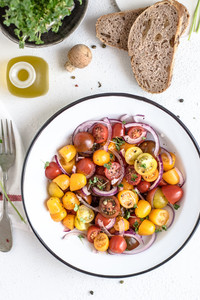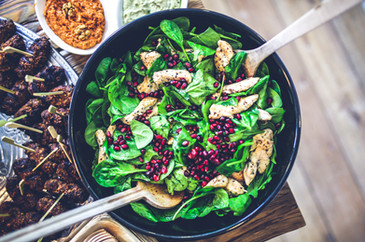Eating with the Seasons: Summer Vegetables in the UK and How to Use Them
- Lois Tirrell

- Jun 25
- 7 min read
Updated: Jun 26
As a dietitian with a keen interest in 'growing her own', one of the most enjoyable parts of my work is helping people reconnect with seasonal eating. In the UK, summer brings an abundance of colourful, flavourful vegetables, each packed with nutrients that support our health. Choosing seasonal produce not only enhances the taste of your meals, but it also supports local farmers, reduces your carbon footprint, and can often be more affordable.

In this post, we’ll take a closer look at the vegetables in season during the UK summer months (June to August), explore their nutritional benefits, and share practical ideas for incorporating them into your meals.
Why Eat Seasonally?
Eating seasonally is more than a trendy food movement, it’s a return to a natural rhythm that benefits our health, our local economy, and the planet. Here’s a deeper look at why it’s worth paying attention to what’s in season.
1. Better for the Environment
When you choose seasonal produce, especially when it’s grown locally, you significantly reduce the environmental impact of your food. Out-of-season vegetables are often imported from far-off places or grown in energy-intensive greenhouses. Both methods use large amounts of fossil fuels- either through air miles or heating, lighting, and irrigating artificial growing environments.

By eating seasonally, you support more sustainable agriculture practices, reduce your carbon footprint, and help decrease food miles. In essence, you’re choosing a way of eating that respects natural growing cycles and contributes to environmental stewardship.
2. Fresher and More Nutrient-Dense
Vegetables harvested in season tend to be fresher because they haven’t spent days or even weeks in cold storage or transit. Fresher produce often retains more nutrients, particularly delicate ones like vitamin C, folate, and antioxidants, which can degrade over time.
For example, freshly picked spinach or peas will generally have a higher nutritional value than their imported, out-of-season counterparts that have travelled across continents. Eating seasonally can mean getting more from your food nutritionally.

3. More Affordable
When vegetables are in peak season, they’re usually more abundant. This abundance helps bring prices down, making fresh, healthy food more accessible. Think of summer courgettes or tomatoes, during a glut, you’ll often find them on sale or offered in bulk at markets.
Buying seasonally also gives you the option to preserve or freeze produce while it’s cheap and plentiful, helping stretch your food budget even further throughout the year.
4. Supports Local Farmers and Food Systems
Choosing seasonal produce often goes hand-in-hand with supporting local growers. Whether you shop at a farmers’ market, subscribe to a veg box scheme, or simply choose UK-grown items in the supermarket, you’re contributing to the resilience of local agriculture.
Supporting these smaller, often more sustainable farms helps preserve biodiversity, traditional farming practices, and food sovereignty- our ability to feed ourselves as a nation without over-relying on imports.
5. Reconnects Us with Food and Nature
There’s something grounding about eating in tune with the seasons. It encourages us to slow down, appreciate what nature provides at different times of the year, and diversify our diet throughout the months. You might find yourself looking forward to the first tender broad beans in June, or making the most of vibrant tomatoes in August.
Seasonal eating also keeps meals varied and interesting. Rather than relying on the same vegetables year-round, it invites creativity in the kitchen and a broader intake of different nutrients.
Summer Vegetables in Season
Here are some of the star vegetables of a British summer:
1. Courgettes
Nutrition: Good source of vitamin C, potassium, and fibre.
How to use:
Spiralise into noodles for a light alternative to pasta.
Roast with olive oil, garlic, and herbs.
Add grated courgette to muffin or pancake batter for extra moisture and veg.
2. Tomatoes
Nutrition: Rich in lycopene (an antioxidant), vitamin C, and potassium.
How to use:
Slice fresh into salads with mozzarella and basil.
Roast with balsamic vinegar and use in pasta sauces.
Blend into gazpacho for a refreshing cold soup.
3. Peas
Nutrition: A good source of plant-based protein, fibre, vitamin K, and B vitamins.
How to use:
Toss into risottos, stir-fries, or pasta dishes.
Make a simple pea and mint soup.
Blend into a dip with lemon, garlic, and olive oil.
4. Broad Beans
Nutrition: High in fibre, plant protein, folate, and iron.
How to use:
Serve warm with a drizzle of olive oil and lemon as a side.
Mix into grain salads with feta and herbs.
Puree into a bright green spread for toast or wraps.
5. Green Beans
Nutrition: Provide fibre, vitamin C, and small amounts of calcium and magnesium.
How to use:
Lightly steam and toss with pesto.
Add to stews or curries.
Stir-fry with garlic and sesame seeds for a quick side.
6. Spinach & Chard
Nutrition: Leafy greens like spinach and chard are rich in iron, folate, and antioxidants such as lutein.
How to use:
Stir into curries, stews, or scrambled eggs/ tofu.
Sauté with garlic as a simple side.
Use fresh in summer salads or green smoothies.
7. Radishes
Nutrition: High in vitamin C and anti-cancer compound glucosinolate.
How to use:
Slice thinly into salads or grain bowls.
Roast whole for a milder, sweeter flavour.
Use as a crunchy topping for tacos or wraps.
8. Beetroot
Nutrition: High in folate, antioxidants, manganese, and nitrates that support blood flow and stamina.
How to use:
Roast and serve in salads with goat’s cheese or walnuts.
Grate raw into slaws or sandwiches.
Blend into hummus or even bake into chocolate cake!
9. Sweetcorn (late summer)
Nutrition: Provides fibre, B vitamins, and natural sweetness.
How to use:
Grill whole cobs and brush with lime and chilli.
Add kernels to salsas, salads, or fritters.
Stir into soups or pasta sauces for added texture.

Tips for Adding More Summer Veg to Your Meals
Sometimes, the challenge isn’t knowing what’s in season, it’s figuring out how to use it consistently. Here are a few ideas to help you increase your veg intake during summer:
Build Veg-Centric Meals
Make vegetables the star of the plate. Start with a base of roasted or grilled summer vegetables and add grains, protein, and a dressing or sauce.
Make Summer Salads Interesting
Move beyond lettuce—use roasted beetroot, grilled corn, radishes, and runner beans to bring texture and colour. Add herbs like mint or basil for a fresh twist.

Add to Sauces & Dishes You Already Make
Toss courgette, spinach, or peas into pasta, curry, or chilli. They blend seamlessly while boosting fibre and vitamins.
Prep Ahead for the Week
Roast a tray of mixed seasonal veg and store in the fridge for quick use in wraps, bowls, or omelettes. Cold roasted veg make a delicious lunchbox addition.
Blend Into Soups, Sauces, or Dips
Don’t overlook dips and soups as a way to sneak in more vegetables.
Use in Breakfasts and Snacks
Vegetables aren’t just for lunch and dinner! Spinach, tomatoes, or mushrooms work brilliantly in omelettes, while veggie muffins make a great snack.

Shopping Tips
1. Choose UK-Grown Produce
Look for produce labelled as UK-grown or British to ensure it's in season locally and hasn’t travelled long distances. This supports local farmers and reduces the environmental impact of your meals.
2. Visit Farmers’ Markets or Farm Shops
Shopping at local markets or farm shops is a great way to access the freshest seasonal produce. You can often chat with growers, learn what’s just been harvested, and even discover varieties not found in supermarkets. Its always worth asking if the produce has been grown without the use of synthetic chemicals or pesticides even if it is not labelled organic. Many small farms follow organic practices but may not be certified due to the cost or complexity of the certification process.

3. Embrace Imperfect Veg
“Wonky” or imperfect vegetables are just as tasty and nutritious as their perfect-looking counterparts, but usually sold at a discount. Buying them helps reduce food waste and can stretch your food budget further.
4. Buy in Bulk and Preserve
If you spot a good deal on seasonal veg, consider buying extra and freezing, pickling, or fermenting them. For example, blanch and freeze peas or broad beans, or pickle beetroot and radishes to enjoy beyond summer.
5. Plan Your Meals Around What’s Available
Allow seasonal produce to influence your meal planning. When courgettes and tomatoes are plentiful, consider recipes that incorporate both, such as ratatouille, pasta primavera, or grilled vegetable platters.
6. Join a Veg Box Scheme
Seasonal veg box schemes (e.g. Riverford, Abel & Cole, or local independents) deliver a curated selection of fresh, seasonal vegetables to your door, often organic and locally grown. It’s a great way to discover new ingredients and support small-scale farming.

7. Learn to Identify What’s in Season
Keep a seasonal produce chart on your fridge or phone, or use apps and websites that track what’s in season in the UK. Knowing what to look out for helps you shop with intention.
8. Grow Your Own (Even a Little!)
If you have space, such as a garden, balcony, or windowsill, you can consider growing fast summer crops like radishes, lettuce, or herbs. This is a cost-effective way to enjoy the freshest produce possible. Additionally, it enhances the microbiome, as 1 teaspoon of soil contains more bacteria than the Earth's population!
9. Be Flexible and Curious
Seasonal shopping means availability can vary week to week. Be open to trying unfamiliar vegetables or varieties, it’s a fun way to expand your cooking repertoire and make mealtimes more exciting.
Final Thoughts
Summer is the perfect time to explore and enjoy the variety of vegetables grown here in the UK. Not only are they fresh and flavourful, but they also provide a wide range of incredible nutrients to support your health.
So next time you’re planning your weekly shop, take a look at what’s in season and challenge yourself to try something new. Your body, tastebuds, and local environment will thank you.

Want more personalised advice on how to eat well throughout the seasons? As a registered dietitian, I can help you tailor your nutrition to your goals and lifestyle. Feel free to get in touch!
















































































Comments